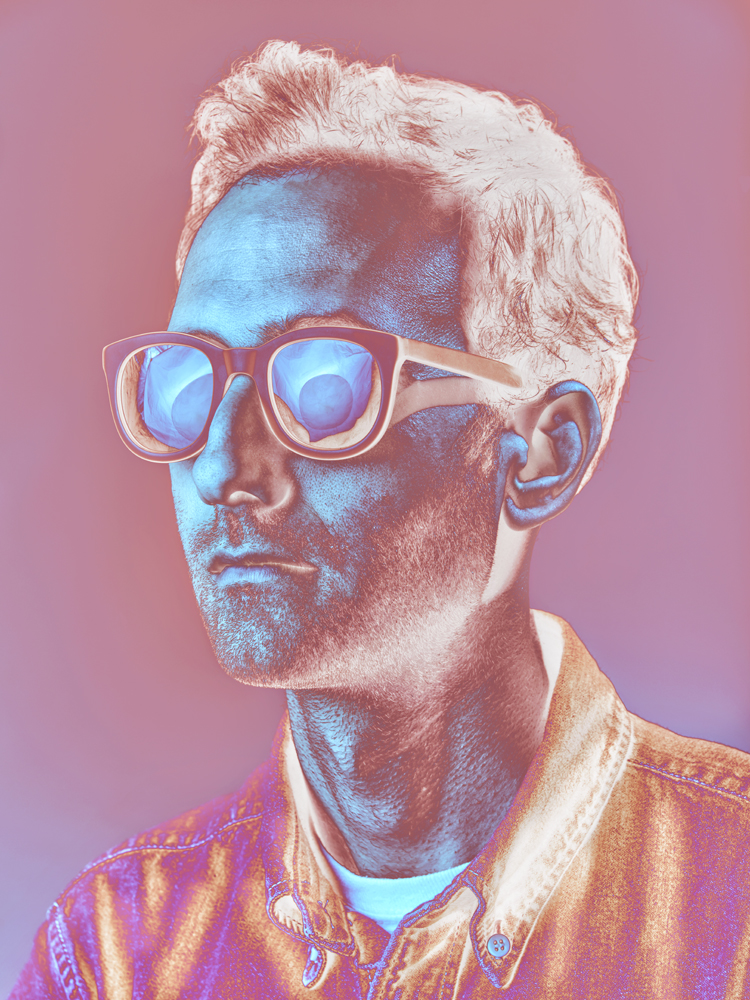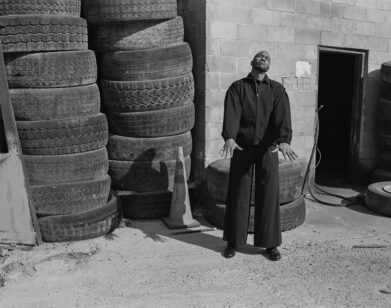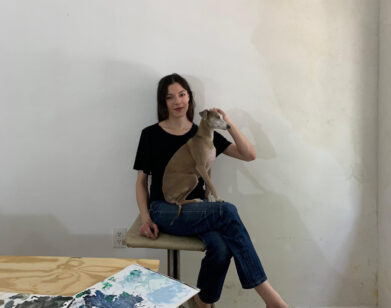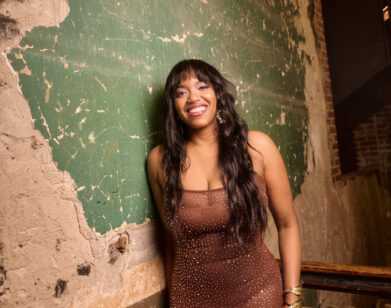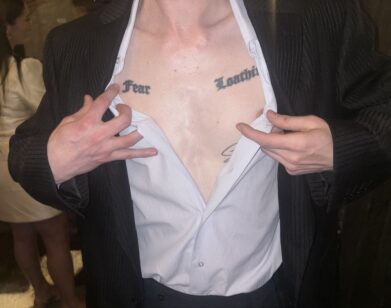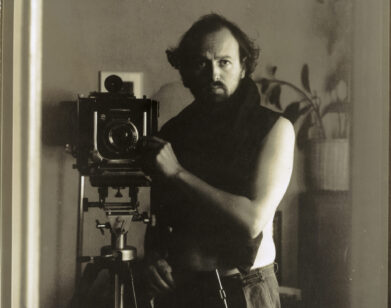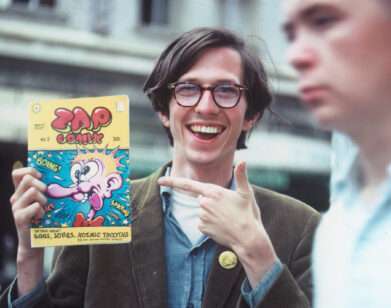Alex Israel
Los Angeles is America. Los Angeles is the place where the American Dream comes to life . . . So much of the imagery that illustrates this dream is pure L.A. cliché. Alex Israel
Artist Alex Israel and I met up at the scenic art department of Warner Bros. in Burbank, California. This is where Israel conducts his “studio visits” and where he makes his scenic sky-backdrop paintings. On this particular day, a new self-portrait was being produced—a fiberglass panel shaped in the artist’s profile (itself adapted from the logo of his 2012 web series As It Lays) and overlaid with a photorealistic image of a seagull in mid-flight. Because I arrived at the end of the workday, the studio was quiet, and the team of painters had already finished their shifts. There were few indicators that the Warner Bros. scenic-art department was working on other projects at the time, but with the increase in digitally printed backdrops, the hand-rendered variety—which Israel espouses—has become something of a dying breed.
Israel’s backdrops, though, are not the first thing he’s done within the context of Warner Bros. in an attempt to inhabit the terrain and operating modes of the entertainment industry since he graduated from the University of Southern California MFA program in 2010. As the 32-year-old Los Angeles native puts it, his art deals in the realities of Hollywood rather than the illusions of cinema. And the production of work through the use of the scenic art department and the studio’s prop house—as he has done through his ongoing series Property, in which he temporarily displays rented props as works of narrative sculpture—represents one strain of this reality. More than simply producing actual art objects, Israel’s practice seems to be about a wider series of social interactions and connections that he has cultivated. This is perhaps best represented in As It Lays, the first iteration of which consisted of 33 stylized video interviews that an emotionless, deadpan Israel conducted with the celebrities, athletes, and personalities who shape the image of L.A. that he so strongly identifies with.
The work that went into making these interviews possible is largely invisible in the final videos, which were serially released online. But it is nevertheless an important part of Israel’s process. It is that behind-the-scenes aspect that leads the artist in his pursuit of Hollywood’s realities and the culture of Los Angeles at large that is distributed on a global scale to audiences around the world, for better or worse.
Our conversation ended on an early Friday evening this past October, so we concluded by going to the nearby Bob’s Big Boy (the oldest operating Big Boy restaurant in the country), where its weekly classic car show was in full swing.
ARAM MOSHAYEDI: Thank you for tuning in to Interview magazine. Today’s subject is Alex Israel. Alex, thank you for being here.
ALEX ISRAEL: Thank you for having me.
MOSHAYEDI: We’ll just get started with the questions. [both laugh]
ISRAEL: Where did you come up with that intro?
MOSHAYEDI: I thought it’d be nice to turn the tables a bit. Alex, do you remember back to 2008? [laughs] When we showed your empty sunglasses display at a storefront in Echo Park?
ISRAEL: Yes, I remember that very well. I still have that display case in my storage. You and Christopher Kreiling invited me to be in a show called “Fall Collection.” I was working on my sunglass brand, Freeway Eyewear, and it wasn’t ready yet. I was still going through the sampling process with my factory, back and forth with different styles in anticipation of my first manufacturing run. I wanted to introduce that project in some way, and because you were doing the show at a store, I thought it was an appropriate context. I bought an empty sunglasses rack and we put it in the store.
MOSHAYEDI: So that was pretty early on for you?
ISRAEL: Yes, and I remember thinking when I got that specific sunglass rack, that it reminded me of Duchamp’s Bottlerack, because it is round and has these little spokes that extended out of it.
MOSHAYEDI: I also remember liking the anticipation factor, as if it were the pre-release party for Freeway Eyewear.
ISRAEL: The coming attraction.
MOSHAYEDI: The coming attraction, exactly. And, obviously, since then, sunglasses have continued to occupy a central part of your work.
ISRAEL: They have. I launched Freeway in the spring of 2010, and I’m still producing new glasses. In fact, I’m working on a collaboration right now with ForYourArt and Raymond Pettibon that will be ready in time for the holidays.
MOSHAYEDI: And you continue to wear them?
ISRAEL: Yep.
MOSHAYEDI: Day and night?
ISRAEL: Always day. Sometimes night.
MOSHAYEDI: I think about your sunglasses as being so prevalent in some ways that I wondered if you’re upset when someone isn’t wearing them. For instance, I’m wearing sunglasses that are by Takahiromiyashita TheSoloIst for Oliver Peoples. And I remember thinking when I got them, “Is Alex going to think that I betrayed him in some way?”
ISRAEL: No, I don’t think that at all. [Moshayedi laughs] It makes me happy when I see people wearing Freeways, but I can’t expect everybody to wear them. They’re not perfect for everyone’s face. People need to find the glasses that best suit them.
MOSHAYEDI: What pair are you wearing now?
ISRAEL: These are Freeway 66.
MOSHAYEDI: I bought a pair of those once. I ordered them when your studio was at Pacific Design Center. I thought I was placing an order anonymously, and then the next day you saw me out, before the glasses arrived in the mail, and said, “Thanks for your order.”
ISRAEL: Right, well, I get to see everyone’s name who orders glasses online.
MOSHAYEDI: Still? To this day?
ISRAEL: Yeah, I get an e-mail every time we make a web sale.
MOSHAYEDI: I think you’ve talked before about the difficulty of focusing on the glasses, because as a business it requires a different kind of attention than a studio-based practice.
ISRAEL: It requires full-time attention, and it’s hard to do both—to run a studio practice and to run a sunglass company. I’ve streamlined my focus toward one special project a year with the sunglasses.
MOSHAYEDI: How would you describe your personal style?
ISRAEL: I’m pretty normcore, maybe with a little bit of a Californian slant. That’s always been my style.
MOSHAYEDI: I think we first met in 2004 or 2005. Is that right?
ISRAEL: Yeah, I think so.
MOSHAYEDI: I don’t know if it was the first time, but I remember you wearing a short-sleeved Planet Hollywood button-up shirt. Do you still have that shirt?
ISRAEL: I still have that shirt. I got it on a day that I was having brunch with Mike Kelley, Emi Fontana, and Bettina Korek. We were in Pasadena, and after eating we all went to the flea market together. I saw the shirt and Mike said I had to buy it, so I did. [laughs] I’m so happy he made me buy it, because I love it.
MOSHAYEDI: Have you ever been to Planet Hollywood?
ISRAEL: Many times.
MOSHAYEDI: I’ve never been.
ISRAEL: I’ve been in different cities and different countries. A lot of them have closed, but during the heyday, they were everywhere.
MOSHAYEDI: I once read that it’s your favorite planet.
ISRAEL: It is.
MOSHAYEDI: I guess to that end, there is a dominant way that your work is discussed in terms of a West Coast aesthetic or the idea of L.A. as subject. And I wondered if you think the interest in your work at this moment somehow dovetails with the recent re-interest in L.A. as an art-world destination?
ISRAEL: I think L.A. has long held a special place in the collective imagination. Because so many of us have grown up watching television and movies that are filmed in L.A., we have an idea of the city that’s tied to televisual and cinematic fantasy. Maybe what you’re getting at is related to a recent excitement surrounding the city in terms of its contemporary art scene?
MOSHAYEDI: I don’t want to talk so much about L.A., because it’s just such an overwrought subject, and I’d rather avoid talking about the clichés.
ISRAEL: I love the clichés.
MOSHAYEDI: Yeah, I know you do. And that’s something to discuss only because there are other narratives of Los Angeles that are not part of the well-worn clichés but that have to do with economic disparity and racial division and things that are not reflected in the reality that is your Los Angeles. Is it worth discussing in this context?
ISRAEL: Beyond its magical regionalism, for me, Los Angeles is America. Los Angeles is the place where the American Dream comes to life. We witness this on television, season after season. The American Dream is a powerful and moving thing. So much of the imagery that illustrates this dream is pure L.A. cliché. These clichés carry so much symbolic weight and meaning; they activate people’s imaginations and inspire them to find a better way, and a better life.
MOSHAYEDI: But the idea of that dream has obviously been contested.
ISRAEL: Of course, but there’ll always be that sliver of hope that keeps the dream alive. I can’t be cynical about that.
MOSHAYEDI: Are you patriotic?
ISRAEL: I love America.
MOSHAYEDI: [laughs] It sounds so weird.
ISRAEL: It does sound weird. But it’s true. America isn’t perfect, but I still love it.
MOSHAYEDI: Well, I don’t want to take that love away from you. [laughs]
ISRAEL: I grew up in a very large family, and every Thanksgiving, we all get together for dinner—it’s usually about 80 people—we have a tradition where my grandmother, great-uncles, and great-aunts, all of whom are first-generation Americans, the children of immigrant parents, get up and lead our entire family in “God Bless America.”
MOSHAYEDI: Oh my God.
ISRAEL: It’s something we’ve done my whole life.
MOSHAYEDI: I think that sincerity translates into your work. Would you agree?
ISRAEL: I hope so. I still find beauty in clichés, and I still find hope in the American Dream. Part of my desire to make As It Lays stemmed from the inspiration I found in my subjects. All of the people I spoke to made L.A. their home or were born here and stayed, and used the city as a platform from which to be their eccentric selves, to do their own thing. In doing so, they affected the path along which culture has evolved. As It Lays is an attempt at creating an archive of those voices.
MOSHAYEDI: Do you have any nicknames?
ISRAEL: Some people call me AI.
MOSHAYEDI: I would have thought your interesting e-mail address was somehow related to a nickname.
ISRAEL: My e-mail address is what I picked for myself when I was 14.
MOSHAYEDI: That makes sense because the e-mail provider you use seems of a specific moment in the internet’s history.
ISRAEL: Yes, I still use America Online. I’m one of the few, but I’m in good company—we’re a loyal bunch. I always get excited when I see someone’s e-mail and they’re still using AOL too. It’s usually someone I think is pretty cool.
MOSHAYEDI: I also want to ask about your relationship to publicity. Through As It Lays or the more recent self-portraits, and even to some degree Freeway Eyewear, which put you in the role of your own living spokesperson—
ISRAEL: Brand ambassador.
MOSHAYEDI: Do you worry about being overexposed?
ISRAEL: No, I don’t worry about that. My projects will all run their courses, and I’ll eventually move on to new ones. Maybe I’ll work on or revisit projects that require my physical presence in the work in the future, but I won’t always be, literally, in all of the work that I make moving forward.
MOSHAYEDI: But I mean more in the social sense. Do you see that kind of exposure as somehow potentially taking away from the work?
ISRAEL: It’s part of the work, part of my process. There are a lot of people who I want to be part of my work or engaged in it. Specifically, as an example, there are the people I’m interested in interviewing for As It Lays, which I see as a three-season project. The first season, which has already been released and which happened in 2012, includes 33 episodes. When the timing is right, I’m going to release the second season, which will be another 33 episodes—the goal being a total of 100 episodes. The way those interviews happened was through social networking: going out, meeting, and connecting with people who could potentially take part or who could put me in touch with potential subjects.
MOSHAYEDI: It’s interesting because I wanted to ask about your peer group—what artists are part of your peer group—but more than this, you’re describing a broader range of connections that you’ve been able to cultivate through living and working in Los Angeles. And through treating these relationships in some way as an extension of your work. It’s not unlike how I imagine your relationship with the people you’re working with to produce your work at Warner Bros.
ISRAEL: My work is very collaborative. I work with a lot of craftspeople, fabricators, and various subjects and their representatives in order to make the work that I do.
MOSHAYEDI: How did you come to establish a relationship with Warner Bros.? I’m also curious about the flow of work, the flow of communication between you and the production team here.
ISRAEL: I started coming to Warner Bros. when I was in graduate school to visit the prop house. I’ve always been fascinated by the film and entertainment industry as a fan—I’m someone who grew up watching television and going to the movies—and I wanted to engage that world and the idea of entertainment in my work. From the very moment I started, I figured out a loophole in the system. If you want to come to the studio, you just have to make an appointment at the prop house. Normally, you’d have to make an appointment for one of the studio tours, and you’d be sequestered to a guided golf cart tour and shown very specific things. However, if you make an appointment at the prop house, you are on your own. Not only can you roam the prop house, but you can take a look around other parts of the lot if you feel so compelled, and that’s what I started doing. I would come to spend time with these props and then go to the Commissary and have lunch, or take a peek inside other buildings and see what was going on. I knew that I had a strong connection to this place because it was always so inspiring every time I’d come to visit. It still is. Being here really gets my imagination going. Initially, I started renting props from the prop house and using them as sculptures, casting them as ready-mades for different temporary exhibitions.
MOSHAYEDI: And did that lead to a relationship with the scenic-art department?
ISRAEL: Right after I finished graduate school, I had this idea about making portraits of people in Los Angeles and using the talk show as a format to do that. I started designing the talk show set, and as the background of the set, I wanted a giant L.A. twilight sky. I did some research and found out that there were just a few places in L.A. that painted backdrops, so I met with the scenic-art department here at Warner Bros. The painter I met was Andrew Pike, who had just painted the backdrop for Conan O’Brien. I thought, “Oh, wow, this is perfect! This is someone who actually paints backdrops for talk shows.” He agreed to paint the backdrop for me, and that’s how the relationship began.
MOSHAYEDI: Which means you’re a client of Warner Bros.?
ISRAEL: Yes, I’m a client, and I work within their structure to fabricate my work.
MOSHAYEDI: You would think that the scenic department at Warner Bros. is under-utilized because the tradition of hand painting has become somewhat outdated as a form.
ISRAEL: That’s exactly how this all ended up working out so smoothly. When I started my relationship with the scenic-art department, they had recently acquired massive new state-of-the-art printers. These printers are now used to make backdrops. All the backdrops that you see on television, which were at one point hand painted, are now simply printed out from high-resolution TIFFs. That technological shift created a void here in this particular space, the scenic-painting loft, and took work away from the scenic painters. The department was happy to have more work that required hand painting. It turned out to be a mutually beneficial relationship.
MOSHAYEDI: Your work with props precedes the painted backdrops. I recently read an earlier interview where you expressed some anxiety around putting another art object in the world. How did you overcome this?
ISRAEL: Time. When I entered school, I had a kind of existential crisis over how to be an artist, what to make, and what that would entail. I worked on a number of solutions that satisfied my desire to participate without compromising my apprehensions about making precious things. This anxiety surely developed out of my experiences working on the commercial side of the art world after college. I ended up developing three projects during graduate school: Property, the rental and display of cinema and television props as temporary ready-made sculpture; Freeway Eyewear, the creation of a nonprecious, mass-produced accessory product and brand; and Rough Winds, a web series designed to exist on the internet.
MOSHAYEDI: I remember when you transitioned from the commercial side of things—working at Sotheby’s, with artist Jason Rhoades, and then for Hauser & Wirth—to being an artist and hearing people say, “Oh, Alex is an artist now.” I remember you saying that you were always an artist. Can you talk about that?
ISRAEL: [laughs] I’ve always been an artist. I was a college art major, and then for five years in between college and graduate school, I worked in various capacities in the art world. I continued thinking about my own work and experimented in making it, but I didn’t really show it to anybody. I was, at that time, scared to pursue my art publicly. A lot of people think that for an artist to have worked on the commercial side of the art world, to the extent that I did, is a breach of purity.
MOSHAYEDI: Someone once said to me, “Isn’t it cheating?”
ISRAEL: Of course it’s not cheating. It’s simply an opportunity to understand our context and to witness certain potentials that exist for art. I’ve always felt that the more information I have about how the art world works, the freer I feel to make my work. I can focus on making it, and I don’t have to be burdened by the weight and anxiety of not knowing what happens to it once it leaves the studio.
MOSHAYEDI: What was your first artwork that you took seriously as an artist?
ISRAEL: I always made art in high school, and I took it very seriously at the time, but what I made then is very different from what I make now. [laughs] I went to a liberal prep school in Los Angeles, where I was encouraged to express myself, to let my feelings out through art, so that’s what I did. But now, thinking about what I still take seriously, I guess one of the very first works I ever showed publicly as an artist must have been that sunglass rack for your show.
MOSHAYEDI: I had no idea. As you said before, your practice involves much more than the production of objects in a studio, and instead involves a larger social apparatus. I guess that’s a given for many artists today, but not for everyone.
ISRAEL: I wear a lot of different hats, and I know that I work across a number of different media and corresponding platforms. At a certain point I recognized that these various roles were organically melding together into a single practice. I’m the umbrella under which it all exists, and ultimately I am the context for my work. I used the language of branding to create my self-portrait logo, to clarify and communicate these conditions.
MOSHAYEDI: But when your public persona switched to being an artist, was there some skepticism that you had to face?
ISRAEL: I think that’s always the case when people change roles in the art world.
MOSHAYEDI: So there was a degree of hesitation from certain people that you had to overcome as an artist, and I wonder how difficult that was? Without getting too Oprah Winfrey …
ISRAEL: I’m not going cry. [both laugh] I’m a workaholic, so there’s not enough time to get too hung up on certain people’s hesitations.
MOSHAYEDI: What do you want the world to know about Alex Israel?
ISRAEL: I asked that question to 33 people for As It Lays, and I think this is my favorite answer, which I’m going to use right now: just that I’m a nice guy.
ARAM MOSHAYEDI IS A WRITER AND CURATOR OF THE HAMMER MUSEUM IN L.A.

